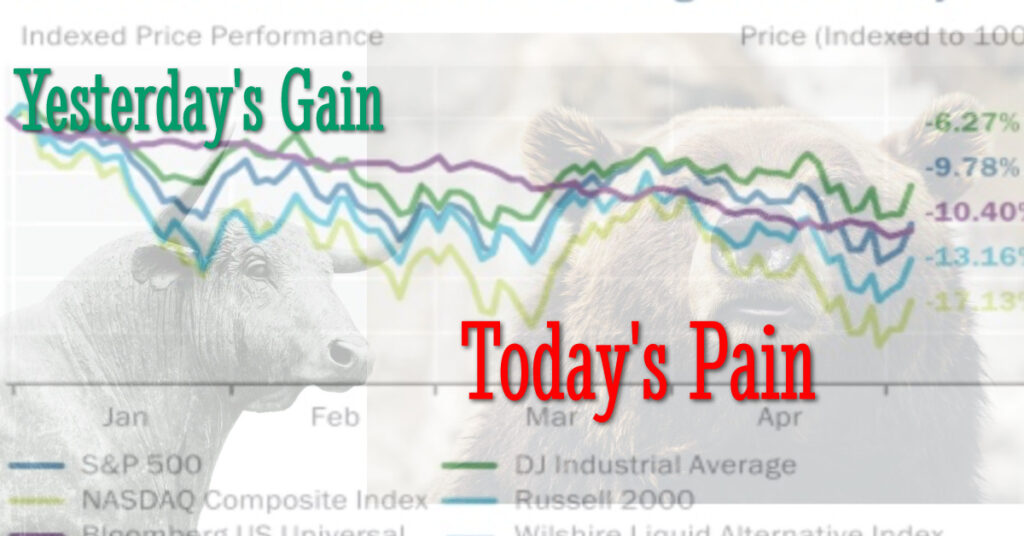Three Uncertainties Driving Volatily
May 5, 2022
Jim Munchbach, CFP®, CLU®, ChFC®, CPCU®
After posting one of its biggest one-day gains in nearly two years yesterday (Wednesday May 4, 2022), the S&P 500 gave it all back today (today May 5, 2022). Today’s 3.6% drop for the S&P 500 was dramatic for sure but the NASDAQ and Consumer Discretionary sector took an even deeper drop of 5% and 6%, respectively. Today’s deeper dive shows extraordinary weakness in many of the (still) high-valuation cloud-related technology names that were down between 10% and 20% on the day.
Selling was not limited to stocks; US Treasury prices fell as well, driving the 10-year yield above the psychologically significant 3% level to a fresh 3 1⁄2 year high. There was some modest steepening in the Treasury yield curve, as seen by a more tepid upward move in the 2-year yield to 2.72%.
Weakness in bond prices was not limited to domestic markets as German Bunds topped 1% for the first time since 2014.
What changed in the last 24 hours? Not much. Today’s sell-off was primarily due to three key uncertainties.
Uncertainty #1: 100 bps Rate Hike is Almost a Certainty
While Fed Chair Jerome Powell removed the likelihood of a 75 basis point (three-quarters of one percent) hike at future meetings, he basically ‘locked’ in the Committee for back-to-back 50 basis points (bp) hikes at the June and July meetings.
Does this mean a combined 100 bp regardless of stock market downdrafts or deteriorating economic conditions? Nobody knows, but this being a certain “path” is a new market concern.
Uncertainty #2: Labor Productivity Dropped 7.5%
Q1 labor productivity (output per hour) declined by 7.5%, the biggest drop since 1947
Uncertainty #3: Unit Labor Costs Jumped 11.6%
Since labor productivity drives a higher standard of living, this piece of data point could be a serious problem. Declining productivity along with higher-than-expected labor costs raises new questions about the future of the economy.
Emotional Volatility
While volatility is definitely uncomfortable for any DIY investor, back-to-back daily swings of 3%+ are downright nerve-racking. It weighs on our emotions and makes us question our investing strategy. All investors share these feelings whether you’re a DIY investor or a pro. Regardless, sound investment strategies can make these volatile periods less emotional.
It’s often during times of market bottoms (think pandemic lows in March 2020) when fear takes over and poor investment decisions are made.
As your Investment Advisor, I want to reinforce the importance of a longer-term outlook for your investments despite these massive swings in volatility.


Wolf Street Report May 5, 2022
Massacre of the Online Retailers Amazon, eBay, Wayfair, Etsy, Shopify, Chewy, The Honest Co., as Folks Shift Spending from Goods Back to Services
On crappy earnings and lowered guidance, many of these highflyers kathoomphed -70% to -85% from highs last year.
#### By Wolf Richter for WOLF STREET May 5, 2022
As consumers shift their spending from goods sold by retailers, to services, the miracle-stimulus-fueled demand for goods is reverting to pre-pandemic trends. Demand for services, which had collapsed during the pandemic, has been rising toward pre-pandemic trends. And the stocks of online retailers, after the hype and hoopla for them during the pandemic, are now getting shookalacked.
A slew of online retailers reported earnings over the past 24 hours, and lowered their outlooks, and what had happened to Amazon [AMZN] is now happening to them too.
Amazon had plunged 14% on April 29 after reporting a big loss, the slowest revenue growth since the dotcom bust, and rip-roaring expenses, topped off by nauseating guidance. Today, Amazon dropped another 7.6%, to $2,328.14, back to April 2020, and is down 38% from its high last July, despite all the financial engineering (a 20-for-1 stock split and mega share-buybacks) announced in March in order to stem the decline by then already under way (data via YCharts):

Wayfair released its earnings today. Revenues plunged by 13.9% from miracle-stimulus Q1 last year to $3 billion, after having already plunged 11% in the prior quarter. The count of active customers plunged by 23.4%, it said. It disclosed a huge loss of $319 million.
The only year the online retailer of furniture and home furnishings ever made a net profit was the stimulus-and-lockdown-miracle year 2020. Over the past five years, including Q1 this year, it lost a total of $2.0 billion.
Wayfair was one of the mega-beneficiaries of the stimulus-and-lockdown-fueled binge by consumers to buy all kinds of goods online, to load up with stuff and to spruce up their homes, given that they’d spend so much more time in them.
In response to this mess, and in delayed response to the Fed yesterday, and in response to the ridiculous share price during the pandemic, Wayfair shares [W] kathoomphed 25.6% today, and 80% from their high in March 2021, to $67.49 a share, a figure first since in June 2017(data via YCharts):

Shopify, the Canadian ecommerce platform, reported that its net income plunged by 90% to $25 million, but at least it’s still making money, unlike some of our other heroes here, such as Amazon and Wayfair. Gross merchandise volume grew 16% and revenues at its Merchant Solutions segment jumped by 29%.
But it lowered its outlook for revenue growth, and shares [SHOP] plunged 14.9% today, to $413.09, down 77% from their high in November 2021. And back to August 2019:

Etsy, the online crafts marketplace, reported that revenues rose only 5%, and net income plunged by 40%, but at least it had a net income. And it gave disappointing guidance, oopsiespalooza.
Etsy’s shares [ETSY] got shookalacked, -16.8% today to $90.93, and -71% from the high in November:
eBay, which has been mildly profitable for years, last night reported a net loss of $1.3 billion – compared to a net profit of $568 million in the quarter a year ago – driven by a loss in its stock holdings. It reported a 6% decline in revenues, with gross merchandise volume down 20%. And it lowered its guidance. Shares kathoomphed 11.7% today, to $48.04, are down 41% from the high in November 2021.

Other online retailer startups got thackamuffled too.
The Honest Co., which was featured in my Imploded Stocks in March, plunged 10.5% today to $3.85 and collapsed by 84% from its high May a year ago:

Chewy [CHWY], the online pet-food retailer that rode up the pandemic stock-jockey fascination with pets – plunged 10.8% today to $29.00 and by 76% from its high in February 2021:

Stitch Fix [SFIX] dropped 3.8% today, to $10.27, bringing the collapse since the high in June last year to 85%:

Enjoy reading WOLF STREET and want to support it? Using ad blockers – I totally get why – but want to support the site? You can donate. I appreciate it immensely. Click on the beer and iced-tea mug to find out how.
Would you like to be notified via email when WOLF STREET publishes a new article? Sign up here.





